Shefford School
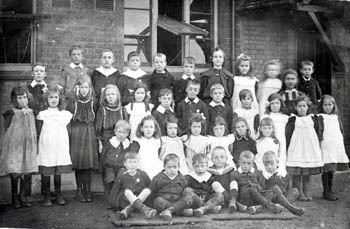
19th century School group [ref: Z50/101/12]
Elementary Education Act 1870
The first Education Act was passed in 1870 (more correctly it was known as the Elementary Education Act). It was a milestone in the provision of education in Britain demonstrating central government's unequivocal support for education of all classes across the country. It also sought to secularise education by allowing the creation of School Boards. These were groups of representatives, elected by the local ratepayers and the Board had the powers to raise funds to form a local rate to support local education, build and run schools, pay the fees of the poorest children, make local school attendance compulsory between the ages of 5 and 13 and could even support local church schools, though in practice they replaced them, turning them into Board run schools (known as Board Schools). Naturally, and luckily for local historians, the Act required a questionnaire of local schools in 1870. The answer for Shefford was that there was "no efficient school" and that accommodation for 212 children was needed. The return noted: "If the Shefford National School be made efficient by building offices and providing school furniture, and by the appointment of a certificated teacher; and if it be enlarged so as to accommodate 266 children (including 54 from Clifton Fields), no further accommodation will be required". This is the first known mention of a National School in Shefford. It is not known whether this was the old Lancasterian School, begun about 1809 by Samuel Whitbread or the school commenced in 1827, or, indeed, another school altogether, begun after 1827. Whatever its ancestry it was certainly in the Old School premises which are now the community hall.
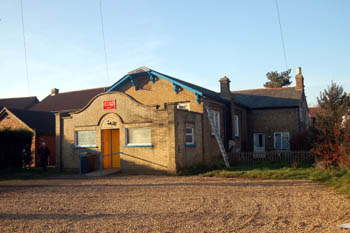
The Old School, February 2008
The Old School
This building was sold in 1911 by the executors and trustees of the will of Ann Maria Smith. In the sale particulars [ref: P70/2/5] it is described as: "a brick and slated building with cottage adjoining known as "The Old School" comprising a large Hall 52 feet 6 inches by 26 feet 6 inches outside Measurement, now used by the Parish as an Assembly Room. Caretaker's Cottage [presumably the old School House for the teacher] with 2 Rooms down and 2 up. Outside Barn with Garden comprising an area 0 acres 0 roods 34 perches (more or less). Tenant The Rev.C.E.Meadows. Nominal Rent 1/-". The parish bought the building at the auction so that it could continue to be used as a parish room.
In 1927 the town of Shefford was valued under the Rating Valuation Act 1925; every piece of land and building in the country was assessed to determine the rates to be paid on it. The valuer visiting the Old School, now the Parish Room, noted [DV1/C290/76] that the hall measured 24½ feet by 50 feet: "Hold 80-100 for a concert or less for a whist drive". "The hiring for an evening is in the hands of the Vicar. Let at 10/6 an evening". The Old School House [ref: DV1/C290/77] was occupied by E.Holmes it was: "Joined to School" and comprised a living room, scullery, two bedrooms and a barn
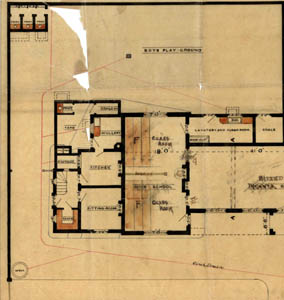
Boys Board School plan [ref: CCE/SB36/8]
The School Board: 1875 to 1903
Shefford School Board was created on 8th March 1875, following the issue of a compulsory order by the Education Department in Whitehall to the effect that one must be set up. This was, in large part, due to the fact that a site for a new Board School had been acquired in 1873 but no Board set up to run it. The new school, set back from Ampthill Road, opened as a Mixed School in 1875 as the first entry in the first logbook [ref: Micf38/23] makes clear: "The school was opened on Monday the 6th [of September] for the first time under the School Board. 61 Pupils were present. Teacher and pupils being alike strange, little good was done for first week. Children seem rather restless & averse to steady work".
Just two years later the school was divided in half - the boys occupying one half of the building, the girls and infants under seven years of age the other. The infants were split off to form a third school in 1891 - the first entry in the new school logbook reading [ref: Micf38/23]: "Examined children, found them backward in all subjects, but more especially in mental arithmetic. Very disorderly in their work". The three schools approach lasted for just nine years as, in 1900, the boys and girls over seven years old reunited to re-form a Mixed School.

Girls and Infants Board School plan [ref: CCE/SB36/8]
During the Victorian period ensuring children attended school regularly and therefore kept up with their work was a constant problem for schools. These extracts from the logbook show some of the reasons for absence, the problems it caused and the measures that could be employed to encourage more regular attendance:
- 27th July 1877: The attendances again on Monday morning were low, and remained so during the day on account of some of the boys being at a treat for the church choir.
- 10th May 1888: The Board have taken proceedings against the parents in two cases of irregular attendance
- 24th October 1890: The attendance was worse than in the previous week. Some children are ill but in the majority of cases there is no excuse for the non attendance. Work progresses very slowly in consequence.
- 13th November 1896: Fred Harris absent without permission beating at Chicksands. The matter is a constant trouble each season, no less than six boys wanting to go, none of whom had got labour certificates, and it affects the attendance of the week seriously.
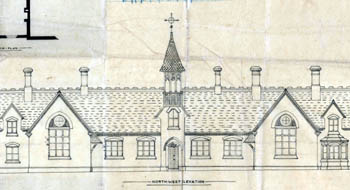
Part of north-west elevation of the Board School [ref: CCE/SB36/8]
1903 to 1939
A land mark Education Act was passed in 1902, coming into effect in 1903. It disbanded the School Boards and gave day to day running of education to newly formed Local Education Authorities, usually the county council, as in Bedfordshire. The old Board Schools thus became Council Schools whilst the old National, British and other non-Board schools became known as Public Elementary Schools. Shefford Board Mixed and Infants Schools thus became Shefford Council Mixed and Shefford Council Infants' School.
Bedfordshire Archives has a scrapbook of cuttings of visits made to most Bedfordshire Schools by School Inspectors for a period from just before the First World War through the inter-war years [ref: E/IN1/1].
The Mixed and Infants' Schools are treated separately in the book, the latter first being visited in 1910: "The Infants' Department continues to be in a very satisfactory condition. Order is excellent, the teaching is careful and intelligent, and the children make thoroughly good progress, The work of the First Class, especially, is in all respects remarkably good. I am surprised to learn that nothing has been done to improve the warming of the Mainroom, and that most of the seats used by the Infants are still without back-rests". This last comment inspired the central government Board of Education to ask of the Local Education Authority: "I am to ask that the Board may be informed at an early date what will be done to improve the heating of the Mainroom, and provide proper seats for the Infants".
The second report is dated 1912, at which point average attendance was 89: "The Infants' Department continues to be suitably, carefully and well taught. An excellent one prevails, and the little ones are bright, happy and make good progress…The premises have been greatly improved by the removal of the galleries and the installation of satisfactory heating apparatus. In this Department, as in the Mixed, the office [toilet] accommodation should be improved and proper provision made for the members of staff". The Education Board has added: "Special attention is invited to the remarks of H.M.I. on the heating of the main-room in the Mixed Department and the inadequacy of the office accommodation in both departments. The Board should be informed of the proposals of the L.E.A. in regard to these matters".
The first report after the Great War, 1924, is very short: "This school is, as usual, taught with marked care and thoroughness, and the children make excellent progress with little apparent effort". The final report in the book is dated 1930, when average attendance was 51: "This department continues to do good, steady work. What is attempted is done well. the methods employed are the traditional collective methods, and for the time the Head Teacher is likely to remain in charge it would be unwise to make drastic changes, but during the inspection and at its close it was demonstrated and explained how the wrok on both classes in Number might be made less abstract and more practical and interesting".
The first report in the book for the Mixed School is dated 1910, when average attendance was 132: "The Senior School continues to be in a very efficient condition. Discipline and tone are very good, the teaching is characterised by earnestness and thoroughness and the scholars display mich mental activity and make sound progress in all branches of their work. The Master supervises effectively and he is wel lsupported by all the members of his Staff; on both him and them the condition of the School reflects much credit". A report of 1912, average attendance 119 notes: "This Department is in a most creditable state of efficiency, orgainsational, tone and order are all praiseworthy. Instruction is, in all classes, characterised by care and intelligence, the children are responsive and make good progress. care is taken that the work done in former years is kept up, and the condition of the school reflects much credit upon the Head Master and his hard-working Staff". The inspector goes no to decry the coldness of the rooms, as reflected in the Board of Education's comments to the Infants' School inspection of the same year.
The first report after the Great war is dated 1923: "There are 152 children on the registers, and the work done is decidedly above the average level found in schools of this size, particularly in the upper classes". The next report, of two years later reads: "This School is going on very well indeed. the work of the upper chasses is generally good and that of the lower is quite satisfactory", it was also noted that the school's singing "carried off the Challenge Shield open to the whole County". The report of 1926 dealt solely with the school garden: "Both plots and paths are ver yweedy and many of the crops have more or less failed. Only an hour a week is given to the work and it is doubtful whether this time is used to best advantage".
The inspection of 1930 was lengthy and analysed the work in each subject in some detail, concluding: "Much of the work in the two lower classes is untidy. the higher of these has been without a regular teacher since Christmas; sometimes without any at all….Both of the upper classes are well taught. The Head Master who has been here four years and teaches the Highest Class, gives what time he can to supervise and help the teachers of the lower group. There is a good tone in the school and in the upper classes the keenness displayed was commendable". The final inspection in the volume dates to 1933 and begins by noting: "In January 1931, the Infants' Department of this school was amalgamated with the Mixed, and all the children were placed under the direction of the present Head Master who now has six classes to control. It can be said at once that since the last report was issued the school has made decided progress. The spirit in which the work is planned, taught, and reviewed is admirable to a degree: there is breadth in the syllabus; vigour and resourcefulness in the presentation of most of the lessons; completeness and intelligence in the conduct of the terminal examinations. The children are delightfully natural in manner; alert and (usually) well informed when questioned about the work they have done; and more than ready to assist in carrying out some of the essential routine duties of the school's daily life".
World War Two
During the Second World War children were evacuated to Shefford from Northwold London County Council School. This meant that there were more pupils than the school had room for making conditions difficult. The war also disrupted the school routine as these two examples show: [ref: Micf38/23]:
- 28th June 1940: School closed for another fortnight – whilst windows are being protected.
- 16th September 1942: Fire Drill and practice for places in shelter during siren.
Shefford was the place of evacuation for the Jewish Secondary School (founded in 1929) which was usually based in Amherst Park, London. 500 Jewish children arrived in Shefford on 1st September 1939. An account if this exodus, written by former headmistress Judith Grunfeld was published in 1980 as: "Shefford: The Story of a Jewish School Community in Evacuation 1939-1945". Although some children were billeted in Shefford others had to stay in Clifton, Stotfold and Meppershall. The children were accommodated in the former cinema until this burned down shortly after their arrival, whereon they moved to The Olde White House in Northbridge Street. The children did not leave the town until August 1945.

New Shefford Lower School south elevation [ref: CA2/395]
1946 to the Present
The third of the great Education Acts was that of 1944 which established the principle of County Primary Schools for children up to the age of 11, at which time they took an examination to determine the nature of the secondary school they would attend until they were 15, the most academically able going to grammar schools, the rest to secondary or secondary modern schools. Shefford Council Mixed & Infants' School thus became Shefford County Primary School.
In the 1970s Bedfordshire County Council introduced comprehensive education, doing away with the 11+ examination and grammar schools and introducing a tier of school between the old County Primary and County Secondary Schools. Thus Lower Schools now taught children aged 4 to 9, Middle Schools from 9 to 13 and Upper Schools from 13 onwards. Shefford County Primary School thus became Shefford Lower School in brand new accommodation in School Lane.
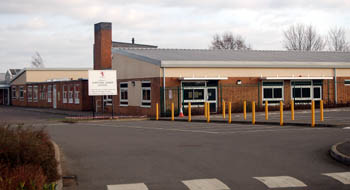
Shefford Lower School, January 2008